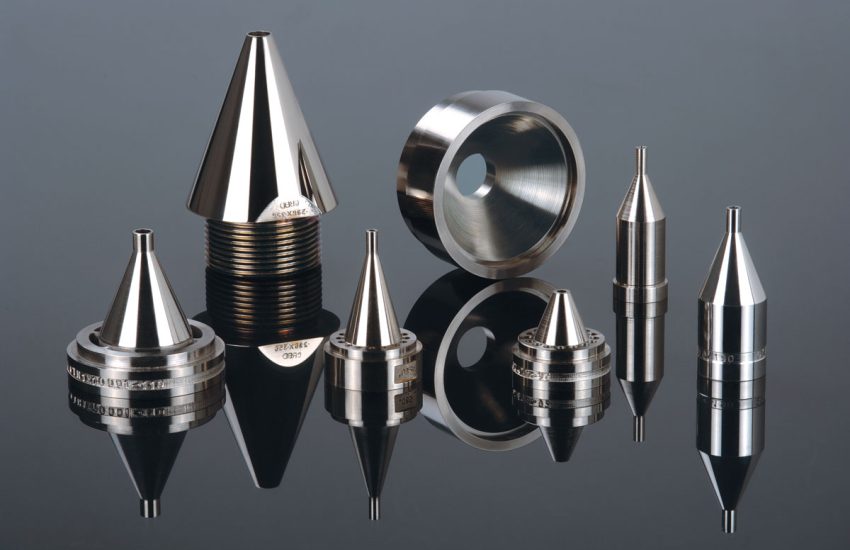Electroless Nickel Plating (ENP) is the deposit of a nickel-phosphorous alloy coating by autocatalytic chemical reduction – without the electric current.
The majority of ENP for engineering purposes is a nickel-phosphorus alloy deposit containing 2 to 13% phosphorus by weight.
Higher the phosphorus content the greater is the corrosion resistance, however, on increasing the phosphorus content, the hardness of the coating decreases.
- Highphos ENP: P-content 10 – 13%, high corrosion resistance (>25 µm, >1000 hrs NSS), hardness as plated 450 – 550 HV
- Midphos ENP: P-content 6 – 9% moderate corrosion resistance (>25 µm, >96 hrs NSS), hardness as plated 550 – 650 HV
- Lowphos ENP: P-content 2 – 5% low corrosion resistance (>25 µm, >24 hrs NSS), hardness as plated 700 – 800 HV

ENP is deposited by reducing Ni2+ cation to metallic nickel with a chemical reducing agent such as sodium hypophosphite or borohydride or DMAB. In the course of chemical reduction, some phosphorous generated gets deposited along with reduced Ni-metal to form a Ni-P Alloy Thickness of 15 – 75 µm, this is very common for most of the application, but for some specific applications high phosphorus ENP can edge above 75 µm also, especially, for very high corrosion and wear resistance requirements.
The advantages of electroless nickel plating
ENP offers excellent corrosion resistance against most of the common corrodents such as saltwater, carbon dioxide, oxygen, and hydrogen sulphide, etc.
High phosphorus deposit of ENP (10-13% phosphorous) is amorphous in nature, which means that there are no grain or phase boundaries to create active sites for the initiation corrosion.
The uniformity of ENP versus electrolytic deposits is very advantageous for plating irregular and complicated shapes of substrates. ENP deposits a uniformly thick coating across the whole substrate; even in slots, holes, and inside walls of the tubing.
Without heat treatment, corrosion-resistant of high phosphorus ENP is very high and also has good hardness and wear resistance properties. Hardness can be increased more than doubled by heat treatment with a bit of compromise in corrosion protection.
ENP offers a cost-effective solution for applications subject to conditions where wear and corrosion are factors; extending service life and providing a lower-cost alternative to corrosion-resistant alloys, particularly where carbon steel suffers localised corrosion; flange attack or weld corrosion.
What are the properties of the deposit and factors affecting them?
ENP provides excellent corrosion protection and uniformity in thickness of deposit along with good hardness. The phosphorus content of the deposit can be chosen as per the requirement of the application.
At Grauer & Weil our technical team understands each customers’ application and its requirement before recommending the optimum phosphorus level – the higher the phosphorus content the greater the corrosion resistance but lower the hardness.
Hardness of ENP can be increased by heat treatment but this produces a micro-crack in the deposit which reduces the corrosion resistance of the coating.
Uniform thickness distribution and alloy composition on complex shapes are the biggest advantages of Electroless plating over electroplating.
How does heat treatment affect ENP?
ENP is at its most corrosion-resistant in its amorphous phase. Heat treatment causes particles of nickel phosphide (Ni-Ni3P) to precipitate, destroying the amorphous character of the deposit. With highphos ENP deposits, this occurs at temperatures between 300 and 395 °C.
How well does ENP adhere to substrates?
Adhesion is dependent on effective cleaning of the substrate. With good surface preparation adhesion to carbon steel is between 200-420 MPa. With stainless steels, the bond strength is usually between 120-160 MPa.
What factors affect plating quality?
There are several factors affecting plating quality and they should be effectively managed by your surface finishing partner.
– Surface preparation: Rough, badly machined surfaces with uneven metal surfaces, burrs, or cold shuts cannot be effectively plated.
– Cleaning: Surfaces must be free from oils, dirt, and soaps formed by saponification of oils by alkaline cleaners.
– Control of the baths and operating parameters: Temperature, pH, nickel ion concentration, and hypophosphite concentration all need to be carefully managed to ensure high quality and consistent plating finish.
What are the fabrication/finishing requirements before plating?
Weld spatter should be removed, sharp edges radiuses and weld roots ground smooth. When refurbishing/remanufacturing components it is important that corroded areas are ground to a flat surface.
Some other key considerations
When looking to choose a suitable partner for your electroless nickel (ni) plating requirements it is important to check for several factors:
– Will surface inspection be completed prior to plating?
– Are the chemicals supplied by a certified ENP product supplier?
– Are ENP solutions made up with demineralized (DM) water?
– Is continuous filtration of the bath to 3 microns done along with air agitation?
– Is bath chemistry (Ni2+, hypo, buffer, etc.) monitored regularly by chemical analysis?
– How regularly are plating Tanks cleaned?
– Is the inspection of the plating line carried out to sufficient levels?



